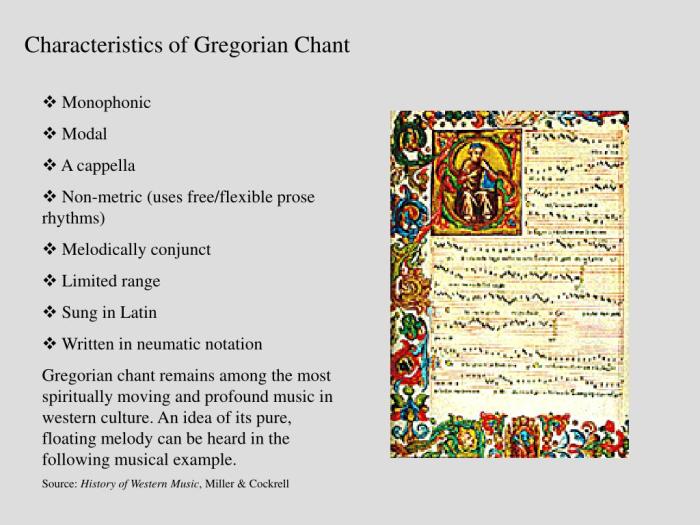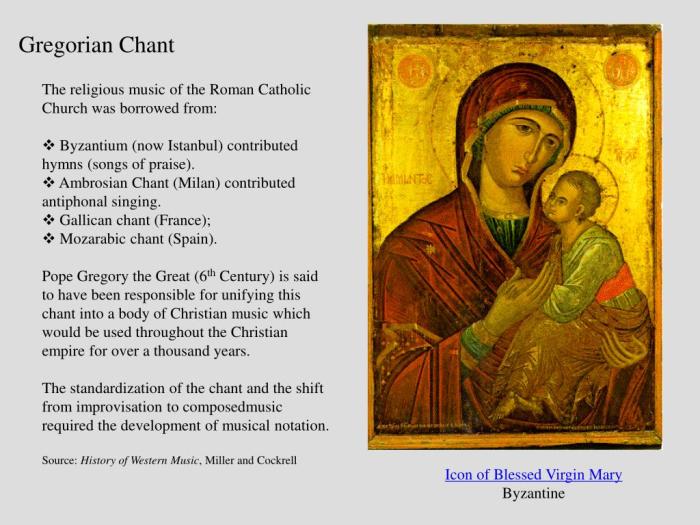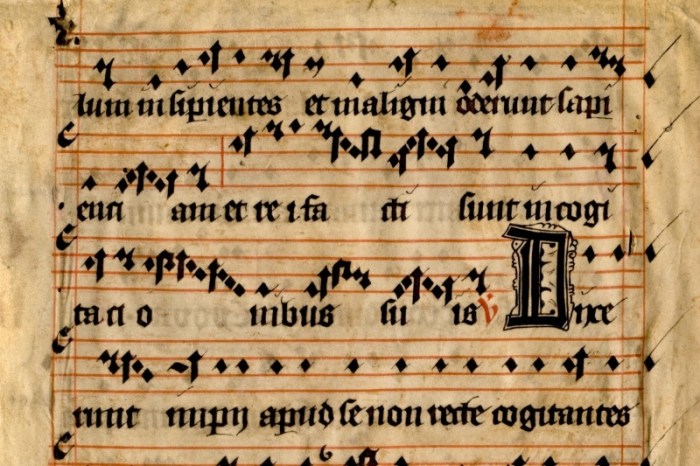Characteristics of a gregorian chant – Delving into the realm of sacred music, we embark on an exploration of the distinctive characteristics of Gregorian chant, a captivating form of monophonic melody that has profoundly shaped the landscape of Western music. From its historical origins to its enduring cultural significance, this ancient chant unveils a rich tapestry of musical and liturgical traditions.
Originating within the Roman Catholic Church, Gregorian chant evolved over centuries, becoming an integral part of religious ceremonies and rituals. Its unique musical qualities, including its monophonic texture, unmeasured rhythm, and modal system, have left an indelible mark on the development of Western classical music.
Historical Origins and Development: Characteristics Of A Gregorian Chant

Gregorian chant emerged during the early Middle Ages, with its roots in the liturgical practices of the Roman Catholic Church. It is believed to have evolved from the monophonic chant traditions of the early Christian Church, influenced by elements of Jewish and Greek music.
The development of Gregorian chant was closely tied to the growth and centralization of the Roman Catholic Church. As the Church established a standardized liturgy, the need for a uniform musical tradition arose. Pope Gregory I (590-604) is credited with codifying and refining the chant, which became known as Gregorian chant in his honor.
Musical Characteristics
Monophonic Nature
Gregorian chant is characterized by its monophonic texture, meaning it consists of a single melodic line without accompaniment. This simplicity allows for clarity and focus on the text, which is central to the liturgical function of the chant.
Unmeasured Rhythm
Gregorian chant lacks a strict rhythmic structure. The notes are notated without specific time values, allowing for flexibility in performance. This rhythmic freedom enables the chant to adapt to the natural flow of the text and the liturgical context.
Modal System
Gregorian chant uses a system of modal scales, which are based on different arrangements of whole and half steps. These modes provide the melodic framework for the chant and contribute to its distinctive character.
Textual Content, Characteristics of a gregorian chant
Liturgical Function
Gregorian chant is primarily used in liturgical ceremonies of the Roman Catholic Church, including the Mass and the Divine Office. It provides a musical setting for the texts of the liturgy, enhancing the prayer and worship of the congregation.
Biblical and Theological Themes
The texts of Gregorian chant are typically drawn from the Bible, Psalms, and other liturgical sources. They often express themes of faith, praise, and supplication, reflecting the theological and spiritual content of the liturgy.
Performance Practices
Vocal Techniques
Gregorian chant is sung using plainchant, a technique that emphasizes clarity and precision in vocal production. Melisma, the extended singing of a single syllable, is also a common feature, adding melodic ornamentation to the chant.
Ensemble Singing
Gregorian chant is typically performed by an ensemble of singers. Precision and intonation are essential for creating a cohesive and harmonious sound, enhancing the liturgical experience.
Accompaniment and Instrumentation
Gregorian chant is usually unaccompanied, although the organ or other keyboard instruments may be used to provide support. The use of instruments is limited, as the emphasis remains on the vocal performance.
Cultural and Historical Significance
Influence on Western Music
Gregorian chant has had a profound influence on the development of Western classical music. Its monophonic texture, modal system, and liturgical function laid the foundation for later musical forms, such as polyphony and harmony.
Preservation and Revival
Gregorian chant has been preserved and revived throughout history. Monasteries played a crucial role in its transmission, and modern-day ensembles continue to perform and record the chant, ensuring its continued presence in the musical and liturgical landscape.
Question Bank
What is the primary function of Gregorian chant?
Gregorian chant is primarily used in liturgical ceremonies, such as the Mass and the Divine Office, as a form of sacred music.
How is Gregorian chant performed?
Gregorian chant is typically performed by a choir or ensemble, emphasizing precision and intonation in vocal techniques such as plainchant, melisma, and ornamentation.
What is the historical significance of Gregorian chant?
Gregorian chant has profoundly influenced the development of Western classical music, shaping its harmonic, melodic, and formal structures.

